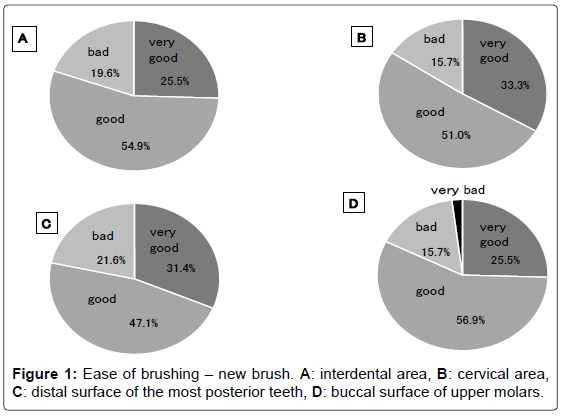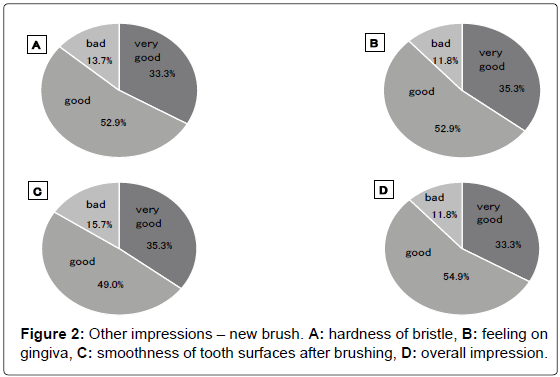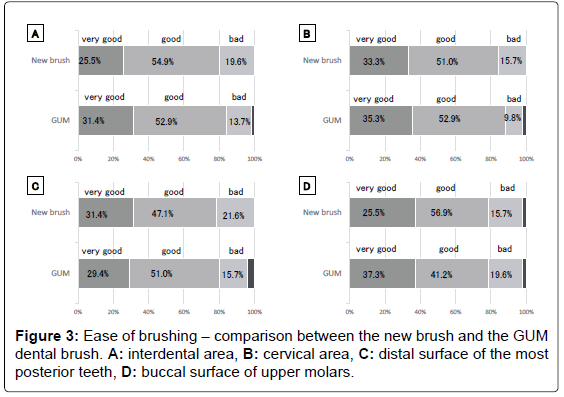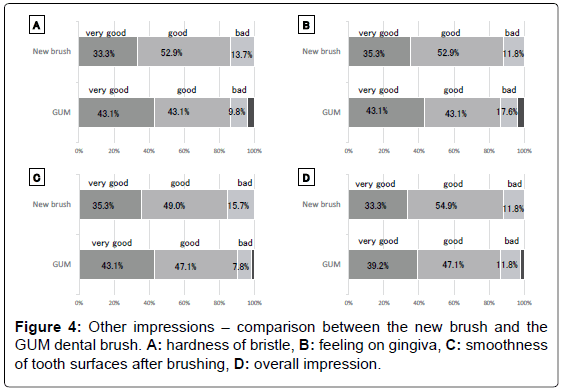Evaluation of a New Ceramic-containing Toothbrush Bristle 1. Questionnaire Survey on Dental Hygienist Students about its Usability and First Impressions
Received: 02-May-2018 / Accepted Date: 07-May-2018 / Published Date: 15-May-2018 DOI: 10.4172/2332-0702.1000240
Abstract
Toothbrushes after use are contaminated by many microorganisms including bacteria, fungi and viruses. We are thinking of making an anti-bacterial toothbrush by including ceramics in the bristle. But if the ceramic-containing bristles are too hard for the tooth and gingiva, it cannot be used as a toothbrush. So, before examining the antibacterial properties, we evaluated the feeling by asking students of dental hygiene. In our preliminary experiment, we determined the most appropriate width and length of ceramic-containing bristles. The students used this toothbrush and answered the questions. Almost all the students were satisfied with the new toothbrush with ceramic-containing bristles. Moreover, the new toothbrush was found to be comparable with the world-wide sold toothbrush. We obtained data that the ceramic-containing bristles were acceptable. Further study to investigate the anti-bacterial properties and effective cleanliness are in progress.
Keywords: Toothbrush; Ceramic-containing bristle; Questionnaire survey
Introduction
Dental caries and periodontitis are two major causes of tooth loss in adults [1]. Both diseases are initiated by a bacterial biofilm, so adequate removal of dental plaque is important for maintaining oral health [2-4].
Recently, several types of new toothbrushes were introduced. For example, a conical shape and extra-thin end bristles are widely sold [5-7]. The bristles are arranged to improve the cleanliness of the tooth surface.
On the other hand, a toothbrush after use is known to be contaminated by bacteria, fungi and viruses [8-11]. Now, we are making a toothbrush by applying a new bristle material: i.e., a bristle that contains ceramics. Some kinds of ceramics are known to have antibacterial activity [12], and our preliminary experiments showed that the ceramic-containing bristle material has an antibacterial property (data not shown). This is advantageous as a toothbrush, because a toothbrush is always exposed to bacteria in the oral cavity. And people do not pay much attention to removing bacteria from toothbrushes, although bacteria on a toothbrush are considered to have a bad effect on general health.
Before making a new toothbrush, we need to confirm that the new bristle material is suitable for a toothbrush, because there is a possibility that the ceramic-containing bristle is too hard for the tooth surface and gingiva. So, we tried to determine the appropriate hardness of bristle by arranging the thickness and length of the bristles. Then, we tried to confirm whether the ceramic-containing toothbrush is acceptable by people. First, we discussed with the teachers of a dental hygienist school and decided on the appropriate thickness and length of the bristles. Next, we examined the most important point, usability and feeling on brushing by questioning dental hygienist students. We also compared the first impressions of the new toothbrush with another toothbrush, which is widely used both in Japan and overseas.
Materials and Methods
Selection of bristle size
The bristles and handles of tooth brush was provided by Zen Corporation (Fukuoka, Japan).We prepared four bristle sizes: thickness 0.15 mm/ length 10.0 mm, thickness 0.15 mm/ length 12.0 mm, thickness 0.18 mm/ length 10.0 mm, and thickness 0.23 mm/ length 12.0 mm. We asked seven teachers of Fukuoka College of Health Science to monitor these four types of toothbrushes for a week.
Evaluation of students’ first impressions
After the most suitable bristle size was decided, we made the toothbrush on a large scale. A total of 61 students of Fukuoka College of Health Science enrolled in this research. We provided the students with the new toothbrush and GUM Dental Brush #211 (Sunstar Inc. Osaka, Japan) and asked them to use the both toothbrushes for 4 days. On the 5th day, we delivered the questionnaire sheets and collected the responses. The questionnaire sheets with complete answers were further analyzed.
All participants understood the nature of the research project and provided written informed consent to participate in this study. Permission for this study was obtained from the Ethics Committee for Clinical Research of Fukuoka Dental College and Fukuoka College of Health Sciences (approval No. 352).
Results
Selection of bristle size
We did a preliminary experiment to identify the most suitable bristle size. Most of the teachers thought that the toothbrush with a bristle size of thickness 0.15 mm/ length 10.0 mm was the best. So, we used this toothbrush for the further survey.
Evaluation of students’ first impressions
A total of 61 dental hygienist students enrolled in this research, and 54 answer sheets were recovered (recovery ratio: 86.5%). The number of complete answer sheets was 51 (the effective answering ratio: 83.6%).
First, we investigated students’ first impressions of the new toothbrush. We asked about the extent of cleaning on different tooth surfaces (Figure 1). More than 80% of students answered that it was easy to clean the interdental spaces, but they had a more positive impression about the cleaning of other areas, such as the cervical and distal surface of the most posterior teeth and the buccal surface of upper molars. Next, we evaluated other properties of the new toothbrush (Figure 2). More than 80% of students had a good impression. They answered that the hardness of the new toothbrush was good, and the feeling on the gingiva was also good. No student thought the new bristle was too hard for the gingiva. They felt that the tooth surface became smooth after brushing.
Next, we compared the new toothbrush with GUM Dental Brush #211, which is widely used both in Japan and overseas. We compared the impressions about cleaning on different tooth surfaces (Figure 3). The impressions of two toothbrushes were found to be almost the same. Other properties of the two toothbrushes were not different (Figure 4).
Discussion and Conclusion
There are many types of toothbrushes, and they have different characteristics [8-11], such as ‘easy to clean the interdental space’, ‘easy to enter the gingival crevice’, ‘gentle on the gingiva’ and so on. Many new toothbrushes are produced focusing on their shape, because a proper shape of the handle and bristles is important to improve the cleaning effectiveness.
On the other hand, toothbrushes are always exposed to bacteria in the oral cavity, and toothbrushes are not necessarily clean [5-7]. Some mouth rinses have been proposed to clean the toothbrushes [13], and chlorhexidine-coatings were made [14]. We are thinking of making an anti-bacterial toothbrush by including ceramics in the bristle. Ceramic is considered to be useful for conferring an antibacterial property on a toothbrush. But if the bristle is too hard for teeth and gingiva, it cannot be used as a toothbrush. So, we confirmed that the ceramic-containing material is acceptable as a toothbrush bristle.
The hardness and feeling on the gingiva varies with the thickness and length of the bristles. So, we first determined the best bristle size by discussing with teachers. We applied the best bristle size to the following questionnaire survey. The dental hygienist students used the new toothbrush, and their impressions were evaluated. Most students had a positive impression, and the impression was almost same with the GUM Dental Brush. The GUM Dental Brush has a long history, and it is used worldwide. From these results, the hardness and feeling on the gingiva of new toothbrush is considered to be acceptable.
The next step, which is to confirm the effectiveness of cleaning and the anti-bacterial activity, is now in progress. We will report the additional properties of the new toothbrush in the near future.
Acknowledgement
This work was supported by JSPS KAKENHI Grants JP16K11577 and JP18K09781.
References
- Richardson JL (1975) Mechanical Plaque Control: A Review of the Literature. J Am Soc Prev Dent 5: 24-29.
- Andlaw RJ (1978) Oral Hygiene and Dental Caries: A Review. Int Dent J 28: 1-6.
- Addy M (1986) Plaque Control as a Scientific Basis for the Prevention of Dental Caries. J R Soc Med 79: 6-10.
- Honkala E, Freeman R (1988) Oral Hygiene Behavior and Periodontal Status in European Adolescents: An Overview. Community Dent Oral Epidemiol 16: 194-198.
- Dorfer CE, von Bethlenfalvy ER, Kugel B, Pioch T (2003) Cleaning Efficacy of a Manual Toothbrush with Tapered Filaments. Oral Health Prev Dent 1: 111–118.
- Sgan-Cohen HD, Vered Y (2005) A Clinical Trial of the Meridol Toothbrush with Conical Filaments: Evaluation of Clinical Effectiveness and Subjective Satisfaction. J Clin Dent 16: 109–113.
- Checchi L, Montevecchi M, Gatto RM, Moreschi A, Checchi V (2007) Clinical Efficacy of Two Toothbrushes with Different Bristles. Int J Dent Hyg 5: 242–246.
- Frazelle MR, Munro CL (2012) Toothbrush Contamination: A Review of the Literature. Nurs Res Pract 2012: 1-6.
- Taji SS, Rogers AH (1998) The Microbial Contamination of Toothbrushes: A Pilot Study. Aust Dent J 43: 128-130.
- Nascimento AP, Watanabe E, Ito IY (2010) Toothbrush Contamination by Candida spp. and Efficacy of Mouthrinse Spray for their Disinfection. Mycopathologia 169: 133-138.
- Glass RT, Jensen HG (1988) More on the Contaminated Toothbrush: The Viral Story. Quintessence Int 19: 713-716.
- Boschetto F, Toyama N, Horiguchi S, Bock RM, McEntire BJ, et al. (2018) In Vitro Antibacterial Activity of Oxide and Non-Oxide Bioceramics for Arthroplastic Devices: II. Fourier Transform Infrared Spectroscopy. Analyst 30: 2128-2140.
- Nascimento CD, Sorgini MB, Pita MS, Fernandes FH, Calefi PL, et al. (2014) Effectiveness of Three Antimicrobial Mouthrinses on the Disinfection of Toothbrushes Stored in Closed Containers: A Randomized Clinical Investigation by Dna Checkerboard and Culture. Gerodontology 31: 227-236.
- Turner LA, McCombs GB, Hynes WL, Tolle SL (2009) A Novel Approach to Controlling Bacterial Contamination on Toothbrushes: Chlorhexidine Coating. Int J Dent Hyg 7: 241-245.
Select your language of interest to view the total content in your interested language
Share This Article
Recommended Journals
Open Access Journals
Article Tools
Article Usage
- Total views: 6709
- [From(publication date): 0-2018 - Oct 06, 2025]
- Breakdown by view type
- HTML page views: 5697
- PDF downloads: 1012




